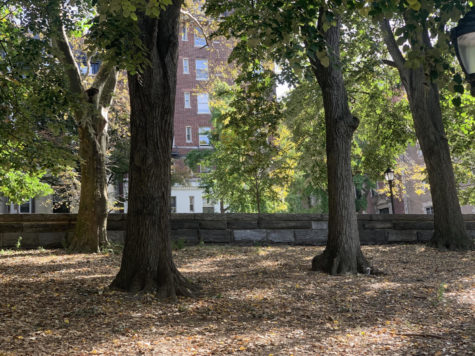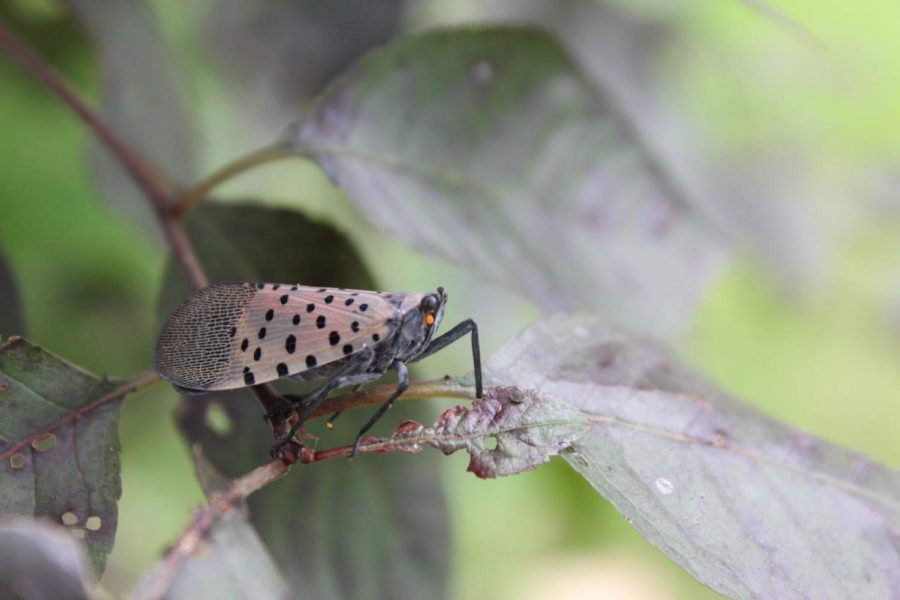The Invasion Happening Under Our Noses: Invasive Species
Don’t judge a book by its cover – despite their appearances, the Emerald Ash Borer and Spotted Lanternfly are some of the most harmful creatures around.
An adult Spotted Lanternfly feeds on a leaf, revealing its distinctive look.
Over the past few decades, the world has continued to globalize at an unprecedented rate, leading to everything from individualized goods to entire cultures being shared over thousands of miles. This revolution has an unseen downside, however. It has facilitated one of the greatest invasions of the 21st century — that of invasive species.
The United States, and especially trade hubs like New York, have been the unfortunate recipients of this spread. Among the new pests that have been introduced, one stands alone with the sheer amount of damage it has caused to ecosystems nationwide: the Emerald Ash Borer.
The Emerald Ash Borer, or EAB for short, carries a small and un-intimidating presence. Because of its shiny jade coloration, it is much more pleasant to the eyes than most of the other pests commonplace in New York, such as cockroaches and horseflies. But appearances are not everything; this tiny beetle has established itself as a serious menace not by directly harassing city goers, but by targeting the state’s native ash tree population.
The EAB could easily be considered a nationwide crisis. To date, it has killed hundreds of millions of ash trees across the Eastern side of the United States, to the point where ash trees could be on the verge of extinction within the next three decades. The impacts of an ash apocalypse might not immediately be evident; however, when considering that ash trees account for over $280 billion in value, are used in everything from baseball bats to furniture, and feed countless species through their seedlings, it is clear that the EAB’s economic consequences are very serious.

So, how has New York been faring? Unfortunately, not very well. Conventional methods like quarantines have proved ineffective thus far against the beetle, which continues to ravage trees at a nearly 100% fatality rate. USDA Department of Agriculture representative Rhonda Santos said that “our Agency removed the federal domestic EAB quarantine regulations because they proved to be ineffective, and doing so allows our Agency to redirect resources to more promising methods.”
What is the more promising method? Wasps. Lots of wasps. But keep in mind, these are not average insectoid pests. These are parasitic, stingless wasps from Russia and Eastern Asia that curb EAB populations by laying their eggs in Ash Borer larva, for those eggs to hatch and kill the undeveloped beetles. Before you start feeling sympathy for the Emerald Ash Borer, consider that this plan could provide sustainable protection for over 900 million ash trees in New York alone, and because the wasps are so specialized towards hunting the EAB, they pose no identifiable danger to New Yorkers or the state’s ecosystems.
Nationally, the wasp rollout has been going smoothly since 2017, and it paints a more promising picture of what the future could hold for America’s most vulnerable trees. Santos added that, “we have released more than 8 million parasitoids in 30 states and the District of Columbia and recovered their offspring in 22 states. This means the wasps are establishing, reproducing, and more importantly, attacking and killing EAB.”
The Emerald Ash Borer is not alone, however. Over the past two decades, a number of small and highly reproductive invasive insects have come to make New York State their new stomping ground, such as the Asian Longhorned Beetle (which targets hardwood trees), the Sirex Woodwasp (which is one of the most dangerous species worldwide targeting pine trees, but has not yet become serious in New York specifically), and probably the most publicized of all, the Spotted Lanternfly.
The Spotted Lanternfly, or SLF, stands out primarily because of the recency of its discovery in New York, and what it has done in Philadelphia over the past decade. The SLF itself does not bore into plant species, but its larvae are known to cause extensive damage. “[W]ith the spotted lanternfly, they can feed on a multitude of vegetation such as grapevine, hops, maple, walnut, and fruit trees,” said Ms. Kuan, AP Environmental Science teacher.
SLFs have primarily gained notoriety for their destruction of private property all throughout Pennsylvania. During their reign of terror, an estimated $42.6 million of damage had been caused, and the flies are still at work. Without a known predator like the parasitic wasps to deal with them, Pennsylvanians have been continuously experimenting — something New Yorkers should take note of if they want to have a hope of dealing with the SLF before it gets out of hand.
One of the more interesting approaches from Pennsylvania has been its use of trap trees. The most popular method is the ‘circle trap,’ where a sticky band is placed along a tree’s trunk to capture greedy lanternflies. Traps also frequently include the invasive ‘Tree of Heaven,’ another Asia native that SLFs have evolved to prefer.
This has been supplemented by the use of predators like the praying mantis and chickens. But by far the most important effort for Pennsylvania has been getting people engaged — average people knowing how to identify and kill a spotted lanternfly is undeniably something New Yorkers will need to become accustomed to.
“It is extremely important for all New Yorkers to understand what an invasive insect, plant or animal is – especially, SLF. The better we educate people on invasive pests, the better we can track and prevent its spread. Many invasive insects, for example, can be hard to identify due to their small size or many look-a-likes. However, SLF is a relatively striking and unique looking pest that spreads great distances only through human movement via trains, shipping, trucking, and vehicles. When more people recognize this pest, they become much more effective at preventing SLF from hitchhiking in a car or on a piece of firewood,” added Lori Severino, a PI Officer at the New York State Department of Environmental Conservation.
Layla Jones, a reporter at Billy Penn and Penn native, added that, “Based on conversations I’ve had with representatives from the Pennsylvania Department of Agriculture and spotted lanternfly researchers, I think the key to curbing infestations is multi-pronged. Here, Philadelphians are strongly encouraged to kill live bugs, target their egg sacks, and to report them to the proper authorities so the state and other relevant stakeholders can take additional mitigation steps.”
At the same time, there still “needs to be a centralized effort to prevent invasive species. Many of these invasive species arrived here accidentally, and in the case of the spotted lanternfly and the murder hornet, they arrived through shipping containers. Therefore, the solution will be a difficult one, but everyone from all over the world will need to be educated and proactive in preventing the spread of invasive species,” added Ms. Kuan.
With invasive pests continuing to spread, the future is hard to predict, but a few things are certain. Going forward, New Yorkers will need to be on the watch for invaders, learning how to identify and stop them. We need action from the government and every individual if the fight for America’s ecosystems is to be won.
Going forward, New Yorkers will need to be on the watch for invaders, learning how to identify and stop them. We need action from the government and every individual if the fight for America’s ecosystems is to be won.
Declan Hilfers is an Editor-in-Chief and Staff Reporter for ‘The Science Survey.’ He is attracted to journalism because it presents an outlet to bring...











